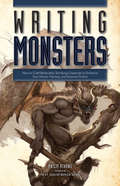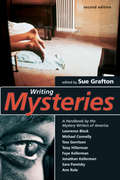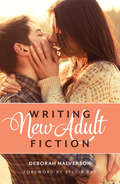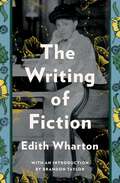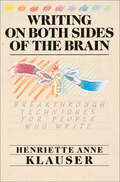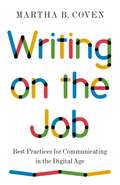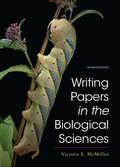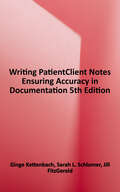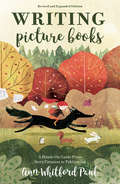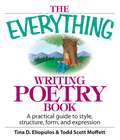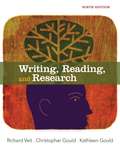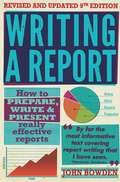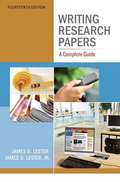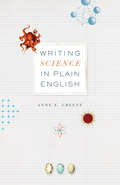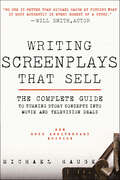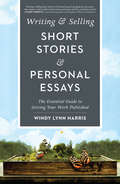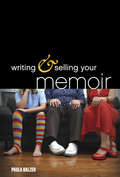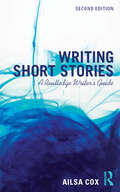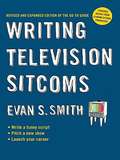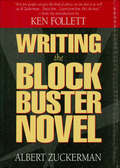- Table View
- List View
Writing Monsters: How to Craft Believably Terrifying Creatures to Enhance Your Horror, Fantasy, an d Science Fiction
by Philip AthansMonsters are more than things that go bump in the night... Monsters are lurking in the woods, beneath the waves, and within our favorite books, films, and games--and there are good reasons why they appear so often. Monsters are manifestations of our fears and symbols of our society--not to mention they're a lot of fun--but each should serve a purpose and enhance the themes and tension in your fiction. In Writing Monsters, best-selling author Philip Athans uses classic examples from books, films, and the world around us to explore what makes monsters memorable--and terrifying. You'll learn what monsters can (and should) represent in your story and how to create monsters from the ground up. Writing Monsters includes: In-depth discussions of where monsters come from, what they symbolize, and how to best portray them in fiction Informative overviews of famous monsters, archetypes, and legendary creatures A Monster Creation Form to help you create your monster from scratch An annotated version of H.P. Lovecraft's chilling story "The Unnamable" Whether you write fantasy, science fiction, or horror, your vampires, ghouls, aliens, and trolls need to be both compelling and meaningful. With Writing Monsters, you can craft creatures that will wreak havoc in your stories and haunt your readers' imaginations--and nightmares.
Writing Mysteries: A Handbook by the Mystery Writers of America (2nd edition)
by Sue GraftonHere's your ticket to the greatest mystery-writing workshop ever!In this extraordinary compilation, more than three dozen members of the Mystery Writers of America share insights and advice that can help make your writing dreams a reality.You'll learn how to:Develop unique ideasConstruct an airtight plot packed with intrigue and suspenseCreate compelling characters and atmospheric settingsDevelop a writing style all your ownWrite convincing dialogueChoose the appropriate point of viewWork with an agentConduct accurate researchand much, much more! You'll also find special guidelines for creating clues, dropping red herrings, and writing medical, legal, historical, true crime, and young adult mysteries. It's all the information you need to solve the mystery-writing riddle!
Writing New Adult Fiction: How to Write and Sell New-Adult Fiction
by Deborah HalversonJoin the New Adult Fiction revolution! From Sylvia Day's Bared to You to Jamie McGuire's Beautiful Disaster, new adult fiction has arrived--and it's hotter than ever. But there's more to this category than its 18-to-26-year-old characters: The success of your story depends on authentically depicting the transition of your young protagonists from teenhood to adulthood. With Writing New Adult Fiction, you'll learn how to capture the spirit of freedom, self-discovery, and romance that defines the new adult experience. Create memorable characters that act and sound like new adults. Sculpt a distinct personality for your fiction with POV, voice, tone, and word choices. Build a unique, captivating plot that satisfies your audience from beginning to end. Learn tools for revising effectively and efficiently in a speed-driven market. Weigh the options for your path to publication: traditional, indie, and hybrid. The new adult category is filled with opportunities to break in with distinct plots and original characters. Make your mark by writing a novel that's fresh, unique--and wholly new adult!
The Writing of Fiction: The Classic Guide To The Art Of The Short Story And The Novel (The\collected Works Of Edith Wharton)
by Edith WhartonA rare work of nonfiction from Edith Wharton, The Writing of Fiction contains brilliant advice on writing from the first woman ever to win a Pulitzer Prize -- for her first novel The Age of Innocence. In The Writing of Fiction, Wharton provides general comments on the roots of modern fiction, the various approaches to writing a piece of fiction, and the development of form and style. She also devotes entire chapters to the telling of a short story, the construction of a novel, and the importance of character and situation in the novel. Not only a valuable treatise on the art of writing, The Writing of Fiction also allows readers to experience the inimitable but seldom heard voice of one of America's most important and beloved writers, and includes a final chapter on the pros and cons of Marcel Proust.
Writing on Both Sides of the Brain: Breakthrough Techniques for People Who Write
by Henriette Anne KlauserA revolutionary approach to writing that will teach you how to express yourself fluently and with confidence for the rest of your life.In Writing on Both Sides of the Brain, author Henriette Anne Klauser offers writers breakthrough techniques to break through blocks and create and communicate yourself through words. From working with procrastination and fending off your inner critic to organizing your material and using creative visualization, this informative and empowering guide will help demystify the Right Brain/Left Brain thought processes and keep your words flowing.“Definitely supportive. The biggest block any writer has is self-judgment. Writing on Both Sides of the Brain helps overcome the obstacles and tap into the creative powers within each writer.” —W. Timothy Gallwey, bestselling author of The Inner Game of Tennis“Amusing, interesting, and stimulating . . . should help many potential writers.” —Pulitzer Prize winner Donald M. Murray
Writing on the Job: Best Practices for Communicating in the Digital Age
by Martha B. CovenA practical and compact guide to writing for professionalsWriting is an essential skill in today’s workplace. From messaging platforms and social media to traditional forms of communication like memos and reports, we rely on words more than ever. Given how much reading we do on mobile devices, being able to write succinctly is critical to success. Writing on the Job is an incisive guide to clear and effective writing for professionals.Martha Coven begins with the basics, explaining how to develop a professional style, get started on a piece of writing, create a first draft, and edit it into a strong final product. She then offers practical advice on more than a dozen forms of writing, from emails and slide decks to proposals and cover letters. Along the way, Coven provides a wealth of concrete examples and simple templates that make the concepts easy to understand and apply.Based on Coven’s popular writing classes and workshops at Princeton University as well as her decades of experience in the public and private sectors, Writing on the Job addresses the real challenges professionals face in today’s digital age, and shares essential practices that can improve the performance of any organization.
Writing Papers in the Biological Sciences
by Victoria E. McMillanWritten by a professional biologist and experienced writing teacher, this comprehensive guide for students provides detailed instruction on researching, drafting, revising, and documenting lab reports, research papers, reviews, poster presentations, and other commonly assigned projects in biology courses. The seventh edition features updated coverage of research methods and new student examples from a wider variety of sub-disciplines in biology that support students at all levels of biology.
Writing Patient/Client Notes: Ensuring Accuracy in Documentation
by Ginge Kettenbach Sarah L. Schlomer Jill FitzGeraldMaster the hows and whys of documentation! Develop all of the skills you need to write clear, concise, and defensible patient/client care notes using a variety of tools, including SOAP notes. <p><p>This is the ideal resource for any health care professional needing to learn or improve their skills--with simple, straightforward explanations of the hows and whys of documentation. It also keeps pace with the changes in Physical Therapy practice today, emphasizing the Patient/Client Management and WHO's ICF model.Section by section you'll learn how to document clearly and accurately, while exercise by exercise you'll practice mastering every step.
Writing Picture Books Revised and Expanded Edition: A Hands-On Guide From Story Creation to Publication
by Ann Whitford PaulMaster the Art of Writing Enthralling Tales for the Youngest pre-and emerging readers! Fully updated and thoroughly revised, Writing Picture Books Revised and Expanded Edition is the go-to resource for writers crafting stories for children ages two to eight. You'll learn the unique set of skills it takes to bring your story to life by using tightly focused text and leaving room for the illustrator to be creative. Award-winning author Ann Whitford Paul helps you develop the skills you need by walking you through techniques and exercises specifically for picture book writers. You'll find:Instruction on generating ideas, creating characters, point-of-view, beginnings and endings, plotting, word count, rhyme, and moreUnique methods for using poetic techniques to enrich your writingHands-on revision exercises (get out your scissors, tape, and highlighters) to help identify problems and improve your picture book manuscriptsUpdated tips for researching the changing picture book market, approaching publishers, working with an agent, and developing a platformAll new quizzes and examples from picture books throughoutNew chapters cover issues such as page turns, agents, and self-publishingWhether you're just starting out as a picture book writer or have tried unsuccessfully to get your work published, Writing Picture Books Revised and Expanded Edition is just what you need to craft picture books that will appeal to young children and parents, and agents and editors.
Writing Poetry Book (The Everything )
by Tina D Eliopulos Todd Scott MoffettGiving voice to ''what gets lost in translation'' is the challenge every poet faces. With The Everything Writing Poetry Book, that challenge just got easier. Featuring examples from works of celebrated poets and instruction on communicating your ideas, this clear and accessible reference helps you gain confidence as you find your own voice. Written by a team who each hold a master’s degree and teach creative writing and literature, this easy-to-follow guide has all you need to take your work to the next level. - With this handy guide, you will learn to:Create meter and rhyme - Express your innermost thoughts - Use imagery and metaphor - Polish your word play - Find your own rhythm - Work with other writersand more - The Everything Writing Poetry Book helps you make the most of this rewarding craft - whether you’re a fledgling poet or a seasoned wordsmith.
Writing, Reading, and Research (9th Edition)
by Richard Veit Christopher Gould Kathleen GouldThis text is a composition course that prepares students for the tasks they will face during their college and professional careers developing skills in writing, reading and analyzing information.
Writing A Report, 9th Edition: How to prepare, write & present really effective reports
by John BowdenNow in its 9th edition, this extensively revised and updated handbook explains how you can write reports that will be: * Read without unnecessary delay * Understood without undue effort Accepted, and where applicable, acted upon / Divided into three parts, the book looks in detail firstly at the practical side of report writing: * Preparation and planning * Collecting and handling information * Writing and revising / Secondly, at the creative side of report writing: * Achieving a good style and choosing the correct words * Improving the overall appearance of reports / And thirdly at 23 common types of report, including: * Annual reports/ Appraisal reports * Audit reports Minutes/Progress reports * Student project reports/Technical reports / There is also an extensive glossary and a selection of sample reports.
Writing A Report, 9th Edition: How To Prepare, Write And Present Really Effective Reports
by John BowdenNow in its 9th edition, this extensively revised and updated handbook explains how you can write reports that will be: * Read without unnecessary delay * Understood without undue effort Accepted, and where applicable, acted upon / Divided into three parts, the book looks in detail firstly at the practical side of report writing: * Preparation and planning * Collecting and handling information * Writing and revising / Secondly, at the creative side of report writing: * Achieving a good style and choosing the correct words * Improving the overall appearance of reports / And thirdly at 23 common types of report, including: * Annual reports/ Appraisal reports * Audit reports Minutes/Progress reports * Student project reports/Technical reports / There is also an extensive glossary and a selection of sample reports.
Writing Research Papers: A Complete Guide (Fourteenth Edition)
by James D. LesterThis market-leading text provides readers with step-by-step guidance through the research writing process, from selecting and narrowing a topic to formatting the finished document. Writing Research Papers backs up its instruction with the most complete array of samples of any writing guide of this nature. The text continues its extremely thorough and accurate coverage of citation styles for a wide variety of disciplines. The fourteenth edition maintains Lester's successful approach while bringing new writing and documentation updates to assist the student researcher in keeping pace with electronic sources.
Writing Science in Plain English
by Anne E. GreeneScientific writing is often dry, wordy, and difficult to understand. But, as Anne E. Greene shows in Writing Science in Plain English,writers from all scientific disciplines can learn to produce clear, concise prose by mastering just a few simple principles. This short, focused guide presents a dozen such principles based on what readers need in order to understand complex information, including concrete subjects, strong verbs, consistent terms, and organized paragraphs. The author, a biologist and an experienced teacher of scientific writing, illustrates each principle with real-life examples of both good and bad writing and shows how to revise bad writing to make it clearer and more concise. She ends each chapter with practice exercises so that readers can come away with new writing skills after just one sitting. Writing Science in Plain English can help writers at all levels of their academic and professional careers--undergraduate students working on research reports, established scientists writing articles and grant proposals, or agency employees working to follow the Plain Writing Act. This essential resource is the perfect companion for all who seek to write science effectively.
Writing Science in Plain English, Second Edition (Chicago Guides to Writing, Editing, and Publishing)
by Anne E. GreeneAn updated edition of the essential guide for all scientists—from undergraduates to senior scholars—who want to produce prose that anyone can understand. Scientific writing is often dry, wordy, and difficult to understand. But, as biologist and experienced teacher of scientific writing Anne E. Greene shows in Writing Science in Plain English, writers from all scientific disciplines can learn to produce clear, concise prose by mastering just a few simple principles. This short, focused guide presents roughly a dozen such principles based on what readers need to understand complex information, including concrete subjects, strong verbs, consistent terms, organized paragraphs, and correct sentence structure. Greene illustrates each principle with real-life examples of both good and bad writing and shows how bad writing might be improved. She ends each chapter with revision exercises (and provides suggested answers in a separate key) so that readers can come away with new writing skills after just one sitting. To help readers understand the grammatical terms used in the book, an appendix offers a refresher course on basic grammar. For this second edition, Greene has incorporated the latest research on what makes writing effective and engaging and has revised or replaced exercises and exercise keys where needed. She has also added new features that make it easier to navigate the book. A new resource for instructors who use Writing Science in Plain English in their classes is a free, online teacher’s guide. Drawn from Greene’s long experience teaching students how to write science clearly, the teacher’s guide provides additional lectures, assignments, and activities that will inform and enliven any class.
Writing Screenplays That Sell: The Complete Guide to Turning Story Concepts into Movie and Television Deals
by Michael HaugeFor more than twenty years, Writing Screenplays That Sell has been hailed as the most complete guide available on the art, craft, and business of writing for movies and television. Now fully revised and updated to reflect the latest trends and scripts, Hollywood story expert and script consultant Michael Hauge walks readers through every step of writing and selling successful screenplays. If you read only one book on the screenwriter's craft, this must be the one.
Writing & Selling Short Stories & Personal Essays: The Essential Guide to Getting Your Work Published
by Windy HarrisWrite It Short, Sell It Now Short stories and personal essays have never been hotter--or more crucial for a successful writing career. Earning bylines in magazines and literary journals is a terrific way to get noticed and earn future opportunities in both short- and long-form writing.Writing & Selling Short Stories & Personal Essays capitalizes on the popularity of these genres by instructing on the two key steps to publishing short works: crafting excellent pieces and successfully submitting them. You'll learn how to:Develop different craft elements--including point of view, character, dialogue, scene writing, and more--specifically for short stories and essays.Recognize the qualities of excellent short works, using examples from recently published stories and essays in major journals.Understand the business of writing short, from categorizing your work and meeting submission guidelines to networking and submitting to writing contests.Master the five-step process for submitting and selling like a pro.Featuring advice and examples from a multitude of published authors, Writing & Selling Short Stories & Personal Essays is a must-have for any writer's bookshelf.
Writing & Selling Your Memoir: How to Craft Your Life Story So That Somebody Else Will Actually Want to Read It
by Paula BalzerThere's more to writing a memoir than just writing your life story. A memoir isn't one long diary entry. Rather, it's a well-crafted story about a crucial, often exceptionally difficult, time in someone's life. Writing & Selling Your Memoirtalks readers through the process of telling their most personal stories in a compelling, relatable, and readable manner. Unlike other books dedicated to the art and craft of writing memoir, it teaches readers how to approach the genre with love, respect, and know-how without sentimentalizing it. Drawing on her experience working with New York Times best-selling memoirists, literary agent Paula Balzer carefully explores the genre and provides readers with step-by-step instruction on how to: Identify strong opening and closing points Find and develop a strong central hook that readers can relate to Structure a memoir to maximize readability Use dialogue and pacing to enhance intimacy Approach honesty and truthfulness Build a successful author platform around their memoir Get an agent's attention Get published Full of tips, techniques, detailed exercises, and examples from best-selling memoirs as well as sidebars from well-known memoir authors,Writing & Selling Your Memoirteaches you how to approach an often tricky genre and tell your story without sentimentalizing it.
Writing Short Stories: A Routledge Writer's Guide
by Ailsa CoxThis new edition of Writing Short Stories has been updated throughout to include new and revised exercises, up-to-date coverage of emerging technologies and a new glossary of key terms and techniques. Ailsa Cox, a published short-story writer, guides the reader through the key aspects of the craft, provides a variety of case studies and examples of how others have approached the genre and sets a series of engaging exercises to help hone your skills. This inspiring book is the ideal guide for those new to the genre or for anyone wanting to improve their technique.
Writing Successful Science Proposals: Third Edition
by Andrew J. Friedland Carol L Folt Jennifer L. MercerAn authoritative how-to guide that explains every aspect of science proposal writing This fully revised edition of the authoritative guide to science proposal writing is an essential tool for any researcher embarking on a grant or thesis application. In accessible steps, the authors detail every stage of proposal writing, from conceiving and designing a project to analyzing data, synthesizing results, estimating a budget, and addressing reviewer comments and resubmitting. This new edition is updated to address changes and developments over the past decade, including identifying opportunities and navigating the challenging proposal funding environment. The only how-to book of its kind, it includes exercises to help readers stay on track as they develop their grant proposals and is designed for those in the physical, life, environmental, biomedical, and social sciences, as well as engineering.
Writing Television Sitcoms (revised)
by Evan S. SmithNew edition of the popular screenwriting guide! Writing Television Sitcoms is the ultimate all-in-one guide to writing a funny script, pitching a new show, and launching a successful career. AS digital technology reshapes the television industry, this new and expanded edition explains how today's writers can get ahead of the curve. Features include: ? A complete description of premise-driven comedy, a proven method for "writing funny from the ground up" ? Numerous examples from new and classic shows ? Advice from top writer-producers ? A thorough look at how sitcom story models are changing ? Complete script layout guidelines for all three formats ? Tips on how new-media developments can help you break into the business
Writing the Blockbuster Novel
by Al ZuckermanEvery novelist dreams of it--writing the book that rockets to the top of the best-seller lists. Now, they can see how it's done, up close, in a book by an agent who has sold manuscripts that turned into hits.<P><P> Here Albert Zuckerman covers the essential elements of the blockbuster novel and shows writers how to put them to work in their books. Zuckerman covers the subject thoroughly, from creating outlines and building larger than life characters to injecting suspense and more. His instruction is decisive, direct and clear and is supported with examples from Gone With the Wind, The Godfather and other blockbusters.
Writing the Paranormal Novel: Techniques and Exercises for Weaving Supernatural Elements into Your Story
by Steven HarperVampires, werewolves, and zombies, oh my!Writing a paranormal novel takes more than casting an alluring vampire or arming your hero with a magic wand. It takes an original idea, believable characters, a compelling plot, and surprising twists, not to mention great writing. This helpful guide gives you everything you need to successfully introduce supernatural elements into any story without shattering the believability of your fictional world or falling victim to common cliches. You'll learn how to:Choose supernatural elements and decide what impact the supernatural will have on your fictional worldCreate engaging and relatable characters from supernatural protagonists and antagonists to supporting players (both human and non-human)Develop strong plots and complementary subplotsWrite believable fight scenes and flashbacksCreate realistic dialogueAnd much moreComplete with tips for researching your novel and strategies for getting published, Writing the Paranormal Novel gives you everything you need to craft a novel where even the most unusual twist is not only possible-it's believable.
